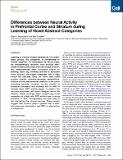Differences between Neural Activity in Prefrontal Cortex and Striatum during Learning of Novel Abstract Categories
Author(s)
Antzoulatos, Evangelos; Miller, Earl K.
DownloadAntzoulatos-2011-Differences between.pdf (970.4Kb)
PUBLISHER_POLICY
Publisher Policy
Article is made available in accordance with the publisher's policy and may be subject to US copyright law. Please refer to the publisher's site for terms of use.
Terms of use
Metadata
Show full item recordAbstract
Learning to classify diverse experiences into meaningful groups, like categories, is fundamental to normal cognition. To understand its neural basis, we simultaneously recorded from multiple electrodes in lateral prefrontal cortex and dorsal striatum, two interconnected brain structures critical for learning. Each day, monkeys learned to associate novel abstract, dot-based categories with a right versus left saccade. Early on, when they could acquire specific stimulus-response associations, striatum activity was an earlier predictor of the corresponding saccade. However, as the number of exemplars increased and monkeys had to learn to classify them, PFC activity began to predict the saccade associated with each category before the striatum. While monkeys were categorizing novel exemplars at a high rate, PFC activity was a strong predictor of their corresponding saccade early in the trial before the striatal neurons. These results suggest that striatum plays a greater role in stimulus-response association and PFC in abstraction of categories.
Date issued
2011-07Department
Massachusetts Institute of Technology. Department of Brain and Cognitive Sciences; Picower Institute for Learning and MemoryJournal
Neuron
Publisher
Elsevier
Citation
Antzoulatos, Evan G., and Earl K. Miller. “Differences Between Neural Activity in Prefrontal Cortex and Striatum During Learning of Novel Abstract Categories.” Neuron 71, no. 2 (July 2011): 243–249. © 2011 Elsevier Inc.
Version: Final published version
ISSN
08966273
1097-4199